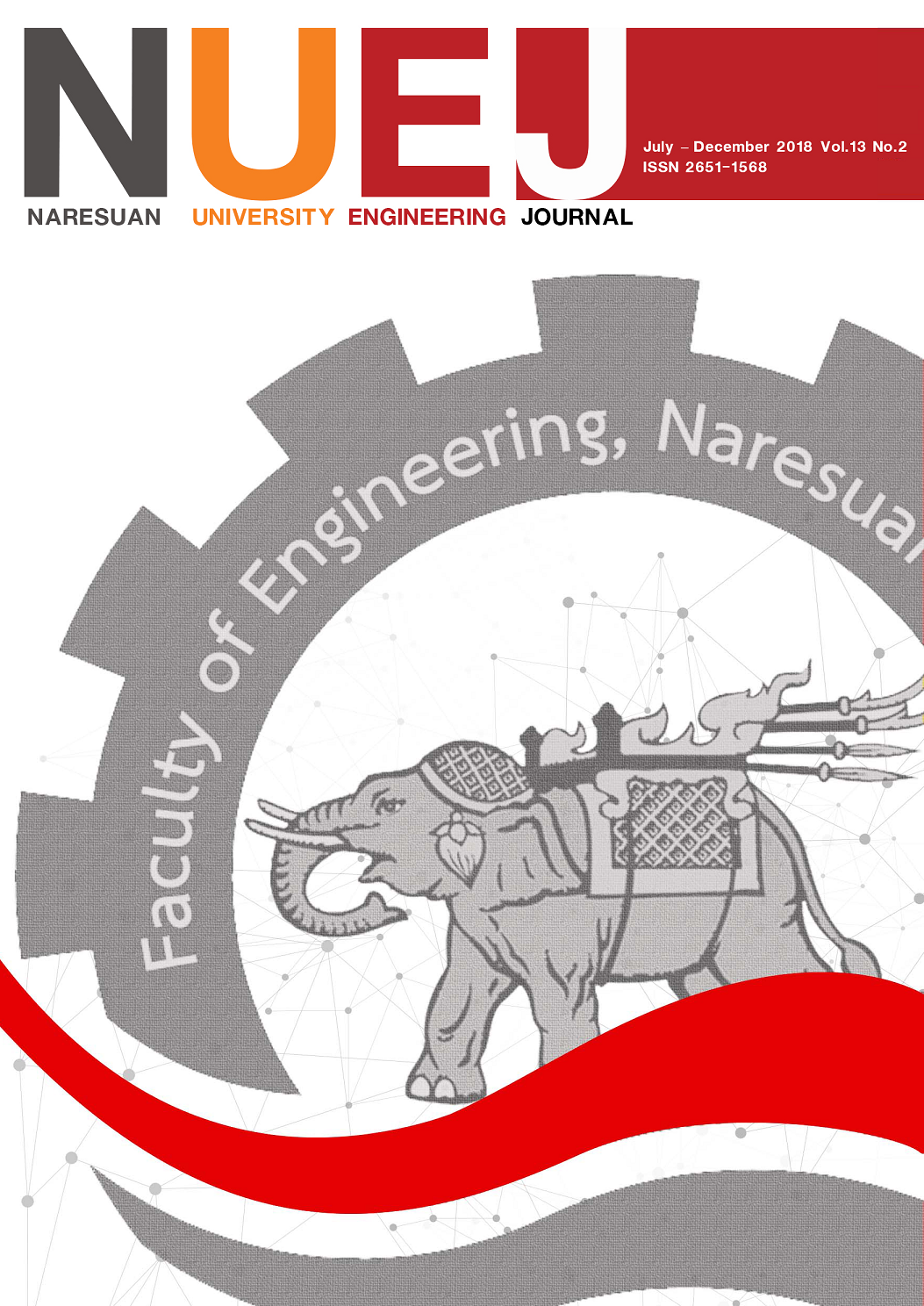Object Recognition for Humanoid Robot using Tactile image processing and Artificial Neural Network
Main Article Content
Abstract
This paper presents an improvement recognition objects system, in the term of touching surface of objects, by using Artificial Neural Networks (ANNs). The experiment of this article is implemented and designed base on the robot hand for installs a sensor array on the robot hand. The sensor array is designed as 16X10 pixels. When the robot hand touches the object, the data is then organized into the image form for processing. This is to identify the characterize of object surface which different objects will provides a different images. This also depends on the force to touch objects. Then the Artificial Neural Networks technique is used to classify the objects. This system is tested with 10 different objects. The experiment results shown that it provides the accuracy approximately 93.2% based on average and standard deviation values.
Article Details
References
[2] Pressure Mapping: Geotechnical Engineering Retrieved Achieve Design and Process Optimization with Interface Pressure Measurement. (2016). Retrieved from https://www.tekscan.com/news/new-ebook-advancing-geotechnical-engineering-pressure-Mapping.
[3] Micah, K. J., & Edward, H. A. (2009). Retrographic sensing for the measurement of surface texture and shape, Computer Vision and Pattern Recognition 2009 : Proceedings of an IEEE Conference on in Miami, FL, USA, 20-25 June 2009 (pp. 1070–1077). https://dx.doi:10.1109/ CVPR. 2009.5206534.
[4] Casselli, S., Magnanini, C., & Zanichelli, F. (1995). On the robustness of haptic object recognition based on polyhedral shape representations, Intelligent Robots and Systems 95. 'Human Robot Interaction and Cooperative Robots' : Proceedings of an IEEE/RSJ international conference in Pittsburgh, PA, USA, 5-9 Aug. 1995 Vol2 (pp 200–206). https://dx.doi:10.1109/IROS. 1995.526160.
[5] Bajcsy, R. (1984). What can we learn from one finger experiments?. Proceedings of a Symposium on Robotic Research Bretton Woods, NH, 1984, (pp. 509–527).
[6] Ronald, S. F., & Binford, T.O. (1991). Using a Cylindrical Tactile Sensor for Determining Curvature. IEEE Transactions on Robotics and Automation, 7, 806 – 817. https://dx.doi:10.1109/70.105389
[7] Bay, S. J. (1989). Tactile shape sensing via single- and multi fingered hands, Robotics and Automation 1989 : Proceedings of an IEEE international conference in Scottsdale, AZ, USA, 14-19 May 1989 Vol 1 (pp 290-295). https://dx.doi:10.1109/ROBOT.1989.100003
[8] Allen, P. K. & Roberts, K. S. (1989). Haptic object recognition using a multi fingered dexterous hand, Robotics and Automation 1989 : Proceedings of an IEEE international conference in Scottsdale, AZ, USA, 14-19 May 1989 Vol 1 (pp 290-295). https://dx.doi: 10.1109/ROBOT.1989.100011
[9] Alexander, S. Jürgen, S. & Cyrill. S. (2009). Object Identification with Tactile Sensors using Bag-of-Features, Intelligent Robots and Systems 2009 : Proceedings of an IEEE international conference in St. Louis, MO, USA, 10-15 October 2009 (pp 243-248). https://dx.doi:10.1109/IROS. 2009.5354648
[10] Khasnobish, A., Jati, A., Singh, G., Bhattacharyya, S., Konar, A., Tibarewala, D. N., Kim, E. & Nagar, A. K. (2012). Object-Shape Recognition from Tactile Images Using a Feed-forward Neural Network, World Congress on Computational Intelligence : Proceedings of an IEEE international conference in Brisbane, QLD, Australia, 10-15 June 2012. https://dx.doi:10.1109/IJCNN.2012.6252593
[11] Datta, S., Khasnobish, A., Konar, A., Tibarewala, D. N. & Janarthanan, R. (2013). Object Shape and Size Recognition From Tactile images, Control Communication and Computing 2013 : Proceedings of an IEEE international conference in Thiruvananthapuram, India, 13-15 December 2013 (pp 16-21). https://di.doi:10.1109
/ICCC.2013.6731617
[12] Alexander, S., Yusuke, B., Kuniaki, N., Hiroyasu, I., Tetsuya, O. & Shigeki, S. (2014). Object Recognition using Deep Learning and Dropout, Humanoid Robots (Humanoids) 2014 : Proceedings of an IEEE international conference in Madrid, Spain, 18-20 November 2014 (pp 1044-1050). https://di:doi 10.1109/HUMANOIDS.2014. 7041493
[13] Harold, S. & Yiannis, D. (2014). Incrementally Learning Objects by Touch: Online Discriminative and Generative Models for Tactile-Based Recognition. IEEE Transactions On Haptics, 7, 512-525. https://dx.doi:10.1109/TOH.2014.
2326159
[14] Somchai, P. & Jakkree, S. (2016) Object Recognition from Human Tactile Image Using Artificial Neural Network, Electrical Engineering/Electronics, Computer, Telecommunications and Information Technology 2016 : Proceedings of an IEEE international conference in Chiang Mai, Thailand, 28 June-1 July 2016. https://dx.doi: 10.1109/ECTICon.2016.7561402
[15] Zachary, P., Erion, P., Caitlin, R. & Gregory, D. H. (2011). Tactile-Object Recognition From Appearance Information. IEEE Transactions On Robotics, 27, 473-487. https://dx.doi:10.1109/TRO.2011.2125350
[16] Alin, D., Gert, K., Arne, B. & Danica, K. (2011). Classification of Rigid and Deformable Objects Using a Novel Tactile Sensor, Advanced Robotics 2011 : Proceedings of an IEEE international conference in Tallinn, Estonia, 20-23 June 2011 (pp 427-434). https://dx.doi:10.1109/ICAR.2011.6088
622
[17] Hiroshi, F., Koichi, I., Tsuyoshi, S., Makoto, T., Takao, S. & Takayasu, S. (2013). Large-Area and Flexible Sensors with Organic Transistors, Advances in Sensors and Interfaces 2013 : Proceedings of an IEEE international conference in Bari, Italy, 13-14 June 2013 (pp 87-90). https://dx.doi:10.
1109/IWASI.2013.6576084
[18] ms9723-pvsr_orig ,Retrieved August 05, 2017, from https://www.kitronyx.com/store/p30/MS9723_FSR_Matrix_Array_Sensor_%2816x10_Rows_and_Columns_%2F_80mm_x_50mm_Active_Sensing_Area%29.html


